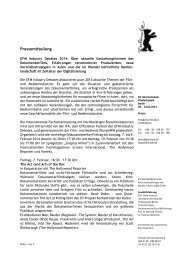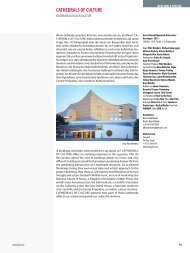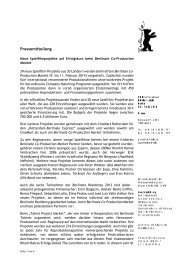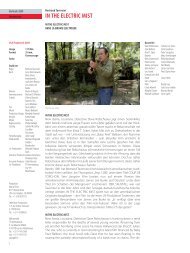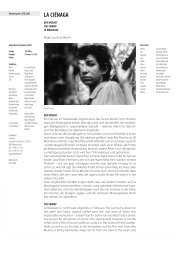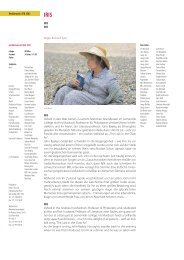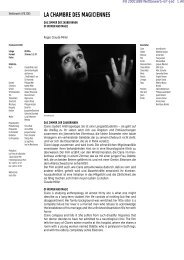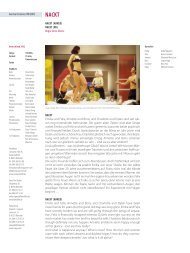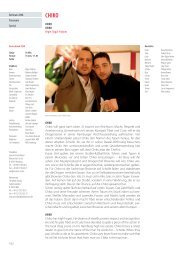Yamanaka Tokiwa - Berlinale
Yamanaka Tokiwa - Berlinale
Yamanaka Tokiwa - Berlinale
Erfolgreiche ePaper selbst erstellen
Machen Sie aus Ihren PDF Publikationen ein blätterbares Flipbook mit unserer einzigartigen Google optimierten e-Paper Software.
ner der beliebtesten historischen Persönlichkeiten Japans im zwölften<br />
Jahrhundert. Der Film lässt die auf der Bilderrolle ‘<strong>Yamanaka</strong><br />
<strong>Tokiwa</strong>’ dargestellte Welt durch Bilder, Worte und eine für den Film<br />
neu komponierte ‘joruri’-Musik [Balladen, die von dreisaitigen ‘shamisen’/Lauten<br />
begleitet werden] wieder neu aufleben: Lady <strong>Tokiwa</strong> macht<br />
sich auf den Weg, um ihren Sohn zu besuchen, der im Norden Japans<br />
lebt, weit weg von ihrer Heimatstadt Kyoto. Auf der Reise wird sie in<br />
<strong>Yamanaka</strong> von Banditen überfallen und umgebracht. Lady <strong>Tokiwa</strong>s<br />
Geist erscheint dem Sohn, der so von dem tragischen Schicksal seiner<br />
Mutter erfährt. Um sie zu rächen, bringt er alle Mitglieder der Bande<br />
um.<br />
Die Bilderrollen in einem Film<br />
In der Spätphase der Heian-Periode (794–1185) und später in der<br />
Muromachi-Periode (1355–1568) waren Bilderrollen äußerst beliebt.<br />
Sie gelten als Höhepunkt der japanischen Malerei und als Ursprung<br />
der heutigen japanischen Animationsfilme und Comics. Lange Zeit<br />
hatte ich daran gedacht, dass es interessant sein müsste, einen Film<br />
über Bilderrollen zu machen.<br />
Die Bilderrolle ‘<strong>Yamanaka</strong> <strong>Tokiwa</strong>’ wird dem Künstler Iwasa Matabei<br />
zugeschrieben, einem Vorreiter auf dem Gebiet des ‘ukiyo-e’ [Bilder,<br />
die das Alltagsleben in der Edo-Zeit darstellen]. ‘<strong>Yamanaka</strong> <strong>Tokiwa</strong>’<br />
besteht aus zwölf Teilen und ist insgesamt einhundertfünfzig Meter<br />
lang. (...)<br />
Vor siebenunddreißig Jahren drehte ich Fuzoku-ga-kinseishoki (Genre<br />
Painting – Edo Period), eine Auftragsarbeit des Tokyo National Museums.<br />
Damals hatte ich zum ersten Mal die Idee, einen Film auf der<br />
Grundlage einer Bildrolle zu drehen. In Frankreich fand zu dem Zeitpunkt<br />
eine Ausstellung mit japanischer Genre-Malerei statt, und bevor<br />
die einzelnen Exponate den jeweiligen Besitzern zurückgeschickt<br />
wurden, wollte das Museum die Bilder auf Film festhalten.<br />
Ich war etwas enttäuscht, als ich diese Genre-Bilder in den Lagerräumen<br />
des Museums sah. Im Halbdunkel konnte ich verschiedene gemalte<br />
Personen erkennen, die leblos auf faltbaren Leinwänden gruppiert<br />
waren. Als ich die Bilder jedoch durch das Kameraobjektiv und<br />
im Licht betrachtete, war ich überrascht. Sie sahen plötzlich ganz<br />
anders aus: lebendig und temperamentvoll. Als ich sie von nahem<br />
betrachtete, war ich von dem souveränen und präzisen Pinselstrich<br />
beeindruckt. Ich dachte, wenn ein Genre-Bild so interessant ist, müsste<br />
eine Bilderrolle, die eine Handlung hat und dramaturgischen Regeln<br />
folgt, noch interessantere Filmbilder hergeben.<br />
Danach beschäftigte ich mich mit verschiedenen Bilderrollen, aber<br />
die, die mir gefielen, waren nationales Kulturgut: Es war unmöglich,<br />
eine Erlaubnis zu bekommen, sie abzufilmen. Daraufhin las ich ‘Kiso<br />
no kefu’ (‘Tracing the Descent of Fantastic Ideas’), ein Buch des Kunsthistorikers<br />
Tsuji Nobuo, und erfuhr von Iwasa Matabei und seinen<br />
Bilderrollen. Zur gleichen Zeit hörte ich, dass der Schriftsteller Yasuoka<br />
Shotaro ebenfalls großes Interesse an Iwasas Bildern hatte. Dank<br />
der Fürsprache von Tsuji Nobuo und Yasuoka Shotaro erlaubte mir das<br />
MOA (Museum of Art), in dessen Besitz sich ‘<strong>Yamanaka</strong> <strong>Tokiwa</strong>’ befindet,<br />
die Bildrolle abzufilmen. (...)<br />
1992, acht Jahre nachdem ich die Erlaubnis erhalten hatte, die Rollen<br />
zu filmen, begann ich mit den Vorarbeiten. Beim Abfilmen von wichtigen<br />
Kulturgütern muss man verschiedene Vorsichtsmaßnahmen treffen.<br />
Das Team darf die Kunstgegenstände nicht berühren. Man darf<br />
nur Filter benutzen, die die Hitze absorbieren – wir arbeiteten mit<br />
2<br />
12th-century hero who is one of the most beloved historical<br />
characters in Japan. The film revives the world of the<br />
“<strong>Yamanaka</strong> <strong>Tokiwa</strong>” picture scroll through pictures and<br />
words, and with the newly composed joruri music (ballad<br />
and shamisen instrumental accompaniment) composed for<br />
the film. Lady <strong>Tokiwa</strong> sets off on a journey to see her son<br />
who lives in northern Japan, quite far from her Kyoto home.<br />
On her way, she is cruelly attacked and murdered by bandits<br />
in <strong>Yamanaka</strong> town. Then the ghost of the resentful<br />
Lady <strong>Tokiwa</strong> appears before her son. Thus learning the<br />
tragic end of his mother, Ushiwaka-maru slays the entire<br />
gang of bandits to avenge her.<br />
The picture scroll in a film<br />
Picture scrolls, very popular through the late Heian (794–<br />
1185) and Muromachi (1333–1568) periods, were the flowering<br />
of Japanese painting and can be considered the source<br />
of the present-day Japanese animation and comics. I had<br />
thought for a long time that it would be very interesting to<br />
make a film that revolves around a picture scroll.<br />
The picture scroll “<strong>Yamanaka</strong> <strong>Tokiwa</strong>” is said to be the work<br />
of artist Iwasa Matabei, a pioneer of “ukiyo-e” (pictures of<br />
everyday life in the Edo period). It is a long scroll consisting<br />
of twelve rolls with a total length of 150 meters. (...)<br />
Back when I made a film titled Fuzoku-ga-kinseishoki (Genre<br />
Painting – Edo Period) for the Tokyo National Museum thirtyseven<br />
years ago, I had come up with the idea of making a<br />
film with a picture scroll. At that time, an exhibition of<br />
Japanese genre paintings was being held in France, and<br />
before returning the paintings to each owner the museum<br />
planned to commit the images to film.<br />
I was somewhat disappointed when I saw those genre<br />
paintings in the museum warehouse. In the gloom, people<br />
of various types were stuck lifelessly on folding screens. I<br />
was surprised however, when I saw them under lighting<br />
through the camera lens. The pictures looked completely<br />
different – animated and bubbly. Gazing at them close up,<br />
I was amazed by the confident, precise brushwork. I thought<br />
that since genre paintings are so interesting, then a picture<br />
scroll, where a story develops dramatically, could produce<br />
even more interesting images.<br />
After that I was drawn to various picture scrolls, but the<br />
ones I liked were national treasure classic paintings and it<br />
was impossible to get permission to film them. Then I read<br />
the book by art historian Tsuji Nobuo titled “Kiso no Kefu”<br />
(Tracing the Descent of Fantastic Ideas), and learned about<br />
Iwasa Matabei and his picture scrolls. At the same time, I<br />
found out that writer Yasuoka Shotaro was also interested<br />
in Iwasa’s works. Fortunately, with the help of Mr. Tsuji<br />
and Mr. Yasuoka, The MOA (Museum of Art) that owns<br />
“<strong>Yamanaka</strong> <strong>Tokiwa</strong>” allowed me to film it. (...)<br />
It was in 1992, eight years after I obtained permission to<br />
film, that I started the actual work. We must always be<br />
very careful when filming important cultural assets. The<br />
filming crew never touches the property. For lighting, a<br />
heat-absorbing filter was used and we filmed with only



